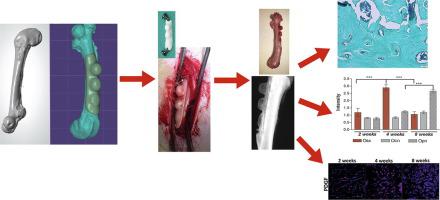Journal of Advanced Research ( IF 11.4 ) Pub Date : 2020-07-23 , DOI: 10.1016/j.jare.2020.07.012 Alexandru Petre 1 , Cornel Balta 2 , Hildegard Herman 2 , Sami Gharbia 2, 3 , Ada Codreanu 4 , Bianca Onita-Mladin 2 , Nicoleta Anghel-Zurbau 4 , Andrei-Gelu Hermenean 5 , Simona-Rebeca Ignat 3 , Sorina Dinescu 3 , Iuliana Urzica 6 , Sergiu Drafta 1 , Luminita Oancea 1 , Anca Hermenean 2, 3, 4

|
Introduction
Obtaining a certain bone volume is an important goal in implantology or orthopedics. Thus, after tooth extraction, quite a lot of horizontal and vertical alveolar bone is lost in time and can be detrimental to the implant treatment outcome, while the treatment of critical bone defects is a considerable challenge for surgery.
Objectives
In this study we designed a new in vivo model as an useful experimental tool to assess guided bone regeneration (GBR) using a computer-aided design/manufacturing (CAD-CAM) space-maintaining barrier.
Methods
The barrier was 3D printed with three progressive heights, surgically placed on rat femur, and GBR results were analyzed at 2, 4, and 8 weeks by X-ray and bone mineral density analysis, histology/morphometry and by immunofluorescence and immunohistochemistry for osteogenesis and angiogenesis evaluation.
Results
The obtained results show that the proposed experimental model provides a real-time useful information on progressive bone tissue formation, which depends on the volume of isolated space created for GBR and on molecular events that lead to satisfactory vertical and horizontal bone augmentation and osteointegration.
Conclusion
In conclusion, the proposed customized three-dome space-maintaining barrier is suitable as an experimental tool to assess the potential of using the designed barriers in dentistry and orthopedics to promote the formation of new bone and determine their space- and time-dependent limitations. Meanwhile, guided bone augmentation for dentistry requires subsequent evaluation on an alveolar bone preclinical model followed by clinical implementation.
中文翻译:

一种使用 3D 打印 CAD/CAM 氧化锆空间保持屏障评估大鼠股骨引导骨再生 (GBR) 的新实验方法
介绍
获得一定的骨量是种植学或骨科的一个重要目标。因此,拔牙后,相当多的水平和垂直牙槽骨会及时丢失,对种植体治疗效果不利,而严重骨缺损的治疗对手术来说是一个相当大的挑战。
目标
在这项研究中,我们设计了一种新的体内模型,作为一种有用的实验工具,使用计算机辅助设计/制造 (CAD-CAM) 空间保持屏障来评估引导骨再生 (GBR)。
方法
屏障是 3D 打印的,具有三个渐进高度,通过手术放置在大鼠股骨上,并在 2、4 和 8 周通过 X 射线和骨矿物质密度分析、组织学/形态计量学以及免疫荧光和免疫组织化学分析了 GBR 结果以用于成骨和血管生成评估。
结果
获得的结果表明,所提出的实验模型提供了关于渐进性骨组织形成的实时有用信息,这取决于为 GBR 创建的隔离空间的体积以及导致令人满意的垂直和水平骨增强和骨整合的分子事件。
结论
总之,所提出的定制三圆顶空间保持屏障适合作为一种实验工具,用于评估在牙科和骨科中使用设计的屏障促进新骨形成并确定其空间和时间依赖性限制的潜力。同时,牙科引导骨增强需要对牙槽骨临床前模型进行后续评估,然后进行临床实施。











































 京公网安备 11010802027423号
京公网安备 11010802027423号